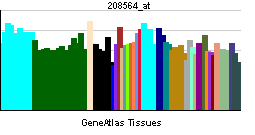KCNA2
| Potassium voltage-gated channel, shaker-related subfamily, member 2 | |||||||||||||
|---|---|---|---|---|---|---|---|---|---|---|---|---|---|
 PDB rendering based on 1dsx. | |||||||||||||
| |||||||||||||
| Identifiers | |||||||||||||
| Symbols | KCNA2 ; HK4; HBK5; HUKIV; KV1.2; MGC50217; MK2; NGK1; RBK2 | ||||||||||||
| External IDs | Template:OMIM5 Template:MGI HomoloGene: 21034 | ||||||||||||
| |||||||||||||
| RNA expression pattern | |||||||||||||
 | |||||||||||||
| More reference expression data | |||||||||||||
| Orthologs | |||||||||||||
| Template:GNF Ortholog box | |||||||||||||
| Species | Human | Mouse | |||||||||||
| Entrez | n/a | n/a | |||||||||||
| Ensembl | n/a | n/a | |||||||||||
| UniProt | n/a | n/a | |||||||||||
| RefSeq (mRNA) | n/a | n/a | |||||||||||
| RefSeq (protein) | n/a | n/a | |||||||||||
| Location (UCSC) | n/a | n/a | |||||||||||
| PubMed search | n/a | n/a | |||||||||||
Potassium voltage-gated channel, shaker-related subfamily, member 2, also known as KCNA2 or Kv1.2, is a human gene.[1]
Potassium channels represent the most complex class of voltage-gated ion channels from both functional and structural standpoints. Their diverse functions include regulating neurotransmitter release, heart rate, insulin secretion, neuronal excitability, epithelial electrolyte transport, smooth muscle contraction, and cell volume. Four sequence-related potassium channel genes - shaker, shaw, shab, and shal - have been identified in Drosophila, and each has been shown to have human homolog(s). This gene encodes a member of the potassium channel, voltage-gated, shaker-related subfamily. This member contains six membrane-spanning domains with a shaker-type repeat in the fourth segment. It belongs to the delayed rectifier class, members of which allow nerve cells to efficiently repolarize following an action potential. The coding region of this gene is intronless, and the gene is clustered with genes KCNA3 and KCNA10 on chromosome 1.[1]
See also
References
Further reading
- Gutman GA, Chandy KG, Grissmer S; et al. (2006). "International Union of Pharmacology. LIII. Nomenclature and molecular relationships of voltage-gated potassium channels". Pharmacol. Rev. 57 (4): 473–508. doi:10.1124/pr.57.4.10. PMID 16382104.
- Paulmichl M, Nasmith P, Hellmiss R; et al. (1991). "Cloning and expression of a rat cardiac delayed rectifier potassium channel". Proc. Natl. Acad. Sci. U.S.A. 88 (17): 7892–5. PMID 1715584.
- Grissmer S, Dethlefs B, Wasmuth JJ; et al. (1991). "Expression and chromosomal localization of a lymphocyte K+ channel gene". Proc. Natl. Acad. Sci. U.S.A. 87 (23): 9411–5. PMID 2251283.
- McKinnon D (1989). "Isolation of a cDNA clone coding for a putative second potassium channel indicates the existence of a gene family". J. Biol. Chem. 264 (14): 8230–6. PMID 2722779.
- Kim E, Niethammer M, Rothschild A; et al. (1995). "Clustering of Shaker-type K+ channels by interaction with a family of membrane-associated guanylate kinases". Nature. 378 (6552): 85–8. doi:10.1038/378085a0. PMID 7477295.
- Klocke R, Roberds SL, Tamkun MM; et al. (1994). "Chromosomal mapping in the mouse of eight K(+)-channel genes representing the four Shaker-like subfamilies Shaker, Shab, Shaw, and Shal". Genomics. 18 (3): 568–74. PMID 7905852.
- Ramaswami M, Tanouy M, Mathew MK (1995). "Facile formation of heteromultimeric potassium channels by expression of cloned human cDNAs". Indian J. Biochem. Biophys. 31 (4): 254–60. PMID 8002006.
- Nakahira K, Shi G, Rhodes KJ, Trimmer JS (1996). "Selective interaction of voltage-gated K+ channel beta-subunits with alpha-subunits". J. Biol. Chem. 271 (12): 7084–9. PMID 8636142.
- Adda S, Fleischmann BK, Freedman BD; et al. (1996). "Expression and function of voltage-dependent potassium channel genes in human airway smooth muscle". J. Biol. Chem. 271 (22): 13239–43. PMID 8662756.
- Bonaldo MF, Lennon G, Soares MB (1997). "Normalization and subtraction: two approaches to facilitate gene discovery". Genome Res. 6 (9): 791–806. PMID 8889548.
- Kim E, Sheng M (1997). "Differential K+ channel clustering activity of PSD-95 and SAP97, two related membrane-associated putative guanylate kinases". Neuropharmacology. 35 (7): 993–1000. PMID 8938729.
- Cachero TG, Morielli AD, Peralta EG (1998). "The small GTP-binding protein RhoA regulates a delayed rectifier potassium channel". Cell. 93 (6): 1077–85. PMID 9635436.
- Tsai W, Morielli AD, Cachero TG, Peralta EG (1999). "Receptor protein tyrosine phosphatase alpha participates in the m1 muscarinic acetylcholine receptor-dependent regulation of Kv1.2 channel activity". EMBO J. 18 (1): 109–18. doi:10.1093/emboj/18.1.109. PMID 9878055.
- Coleman SK, Newcombe J, Pryke J, Dolly JO (1999). "Subunit composition of Kv1 channels in human CNS". J. Neurochem. 73 (2): 849–58. PMID 10428084.
- D'Adamo MC, Imbrici P, Sponcichetti F, Pessia M (1999). "Mutations in the KCNA1 gene associated with episodic ataxia type-1 syndrome impair heteromeric voltage-gated K(+) channel function". FASEB J. 13 (11): 1335–45. PMID 10428758.
- Wade GR, Laurier LG, Preiksaitis HG, Sims SM (1999). "Delayed rectifier and Ca(2+)-dependent K(+) currents in human esophagus: roles in regulating muscle contraction". Am. J. Physiol. 277 (4 Pt 1): G885–95. PMID 10516156.
- Poliak S, Gollan L, Martinez R; et al. (2000). "Caspr2, a new member of the neurexin superfamily, is localized at the juxtaparanodes of myelinated axons and associates with K+ channels". Neuron. 24 (4): 1037–47. PMID 10624965.
- Manganas LN, Trimmer JS (2000). "Subunit composition determines Kv1 potassium channel surface expression". J. Biol. Chem. 275 (38): 29685–93. doi:10.1074/jbc.M005010200. PMID 10896669.
- Kuryshev YA, Wible BA, Gudz TI; et al. (2001). "KChAP/Kvbeta1.2 interactions and their effects on cardiac Kv channel expression". Am. J. Physiol., Cell Physiol. 281 (1): C290–9. PMID 11401852.
- Byron KL, Lucchesi PA (2002). "Signal transduction of physiological concentrations of vasopressin in A7r5 vascular smooth muscle cells. A role for PYK2 and tyrosine phosphorylation of K+ channels in the stimulation of Ca2+ spiking". J. Biol. Chem. 277 (9): 7298–307. doi:10.1074/jbc.M104726200. PMID 11739373.
External links
- Kv1.2+Potassium+Channel at the US National Library of Medicine Medical Subject Headings (MeSH)
- KCNA2+protein,+human at the US National Library of Medicine Medical Subject Headings (MeSH)
| Stub icon | This membrane protein–related article is a stub. You can help Wikipedia by expanding it. |
This article incorporates text from the United States National Library of Medicine, which is in the public domain.